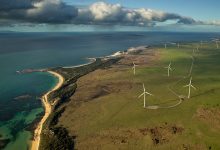While Australia’s federal Coalition refuses to accept the notion that Australia can reach 50 per cent renewables without sorcery and/or total economic destruction, Tasmania’s Liberal government has just announced a possible world-first: A renewable energy target of 200 per cent by 2040, powered by a doubling of the tiny island state’s hydro, wind and solar energy production.
In his State of the State address on Tuesday, Premier Peter Gutwein said his government was looking well past its 100 per cent by 2022 target, and would release an updated Renewable Energy Action Plan – informed by science – next month, to ensure Tasmania remained the “renewable energy powerhouse” of Australia.
“Today we are announcing a new renewables generation target of 200 per cent of our needs by 2040, which will see Tasmania double its renewable production,” Gutwein said in the speech.
“Tasmania has the opportunity to ensure that the most compelling 21st century competitive advantage that industry and consumers want – renewable energy – underpins our economy… attracting investment, creating jobs and also supporting Australia’s transition to a renewable base load supply.”
The new target, which is certainly a first for any government in Australia, and potentially unequalled anywhere else in the world, follows the announcement of a $50 million Tasmanian Renewable Hydrogen Action Plan on Monday.
That plan will see funds divided between a $20 million Tasmanian Renewable Hydrogen Fund, $20 million in concessional loans, and up to $10 million in support services, to help kick-start the industry in the state.
“Our vision is to have a renewable hydrogen generation facility up and running in Tasmania by 2022-2024, and to be commercially exporting hydrogen by 2030, creating hundreds of local jobs and injecting billions into the Tasmanian economy,” Gutwein said on Monday.
The premier said in his address on Tuesday that Tasmania had a proud history as a “quiet leader” on climate action, which is a great deal more than the government’s federal counterpart can say on the topic.
In particular, the hydro-power rich state has set a high benchmark on greenhouse has emissions, which Gutwein noted had declined by 95 per cent from 1990 levels.
“The last greenhouse gas inventory shows that for the sixth year in a row we have met our legislated emissions reduction target,” he said.
“And we have the lowest per capita emissions of all States and Territories and are one of the lowest net emitters of carbon dioxide on the planet.
“It is now time to showcase our innovation to the world and stake our claim as a renewables powerhouse.”
And while Tasmania has had a big head start on other states – being all but 100 per cent renewable thanks to its well established hydro generation resource – getting to the 200 per cent mark will require a few major pieces of the infrastructure puzzle to fall into place, first.
Chief among these is the development of the Marinus Link – a proposed second interconnector linking Tasmania to the mainland that is said to have the potential to unlock up to $5 billion in new Tassie renewables investments, including huge wind farms and pumped hydro.
“We are currently progressing the Marinus link, which is set to underpin 1,400 new jobs in Tasmania, with up to 2,350 jobs also being created from further renewable energy investment and our nation-leading Battery of the Nation proposal,” said Gutwein.
“The combined investment has the potential to inject $7.1 billion into the Tasmanian economy over the coming years – leaving no one in any doubt that Tasmania is in fact the battery of the nation.”
But Gutwein is not under the illusion any of this will be easy. “Any new target needs to be evidence-based and informed by both science and economics,” he said.
“I have requested that central agencies DPAC and Treasury, in concert with DPIPWE and State Growth, conduct a detailed analysis of the pathway our state would need to take and the impacts on industry and jobs to achieve a target of zero net emissions prior to 2050.
“This process will include targeted consultation with industry, the business sector and the community and will occur over the next 6 months. The outcomes of the consultation will inform amendments to the Climate Change Act and Tasmania’s new Climate Action Plan for post 2021.”
Meanwhile, he said, his government would ensure the state continued to lead the nation on renewable energy, such as the 112MW Granville Harbour wind farm which commenced generation for the first time last week, and is hoped to get the state past the 100 per cent mark.
Now that is how climate policy is done.








